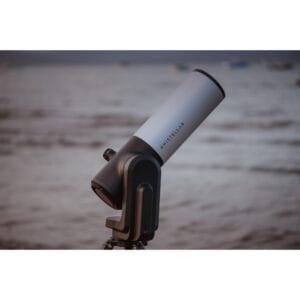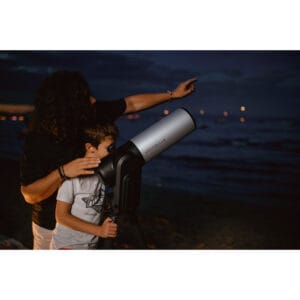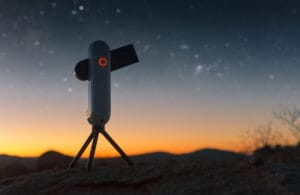Frequently Asked Questions About Telescopes: stargazing raises many questions. What can you see with a telescope? How do you use it? And which telescope is suitable for your goals? In this comprehensive overview, we answer the 29 most frequently asked questions, grouped by theme. This ensures you’ll start off right.
Basic Questions about Telescopes
1. What’s the Difference between a Telescope and an Astronomical Telescope?
Both terms are often used interchangeably. Technically, an astronomical telescope is usually a refracting telescope (refractor). But in practice, people mean the same thing with both: an instrument for observing the sky.
2. What’s the Difference between a Refractor and a Reflector?
A refractor uses lenses and is good for moon and planets. A reflector uses mirrors and is better for deep-sky objects like nebulae. Refractors are low maintenance, reflectors sometimes need collimation.
3. What Do Focal Length and Aperture Mean?
The aperture determines how much light the telescope captures. The focal length determines, together with the eyepiece, the magnification. The larger the aperture, the more detail you see.
4. How much Magnification Do I Need for Planets?
Between 80x and 150x is ideal. More magnification doesn’t automatically mean a sharper image. Air quality and the eyepiece also determine how much detail you see.
5. What’s a Good Telescope for Children?
A compact, user-friendly telescope like the Sky-Watcher Heritage 100P or the Celestron StarSense 70AZ is ideal for children.
What Can You See with it?
6. What Can You See through a Telescope in Clear Weather?
The Moon in detail, Saturn’s rings, Jupiter’s moons, the phases of Venus and — with some practice — nebulae and galaxies.
7. Can You See Planets with a Small Telescope?
Yes. Even with a 70mm telescope, you can see Jupiter and Saturn. Details increase with the telescope’s aperture.
8. Can You See Deep-Sky Objects with a Beginner’s Telescope?
Yes, but subtly. Think of the Orion Nebula or the Andromeda Galaxy. You’ll hardly see colors, mainly light patches or structures.
9. Why Don’t I See Colors like in NASA Photos?
NASA photos are composite images often taken with long exposure times. Visually, you’ll mainly see white, gray, or soft yellow.
10. Can You Really See Saturn’s Rings?
Absolutely. Even with a quality entry-level model, you can clearly see the rings — a magical moment for every beginner.
Use and Settings
11. How Do You Focus a Telescope?
Use the focusing wheel while looking at an object. Always start with a low-power eyepiece (e.g., 25mm) and work your way up.
12. How Do I Point a Telescope at a Planet?
Use a red dot finder or finder scope and start with a bright object like the moon. Then find Jupiter or Saturn using an app like Stellarium or SkySafari.
13. Why Can’t I See Anything through My Telescope?
Possible causes: incorrect focus, lens caps not removed, wrong eyepiece, or poor finder alignment.
14. How Does an Eyepiece Work?
The eyepiece determines the magnification. You switch them depending on what you want to see. A 25mm is for wide fields, a 10mm for more detail.
15. What is Collimation and Do I Need to Do it?
Collimation is aligning mirrors in a reflector. It’s important for a sharp image. Refractors don’t need collimation.
Accessories Upgrades
16. Which Eyepieces Do I Need?
A combination of 25mm (wide field), 10mm (planets), and optionally a 6mm for details. Avoid cheap 4mm low-quality eyepieces.
17. What Does a Barlow Lens Do?
A Barlow doubles or triples your eyepiece magnification. Note: only useful with good optics.
18. Do I Need Filters for Planets or the Moon?
Not mandatory, but a moon filter reduces bright light and color filters can enhance details on Jupiter or Mars.
19. What is a Moon Filter and Do I Need one?
Yes, if you often observe the Moon. It reduces the bright light, preventing eye strain and showing more contrast.
20. How Does a Solar Filter Work and is it Safe?
A solar filter goes in front of the telescope aperture. Only then is it safe. Never use a filter behind the eyepiece. Only buy from reliable brands.
Smart Telescopes Astrophotography
21. What is a Smart Telescope?
A smart telescope is a fully automated telescope with camera, like the Seestar or Vespera. You control it via an app.
22. Can I Take Photos with a Beginner’s Telescope?
Yes, of the Moon or Jupiter using your smartphone. For deep-sky, you need a tracking mount or smart telescope.
23. Do I Need a Tracking System?
For photography: yes. For visual use it’s not mandatory, but convenient.
24. What’s the Difference between Visual Observing and Astrophotography?
Visually, you see faint objects in grayscale. Photography allows long exposures, with much more color and detail.
Purchase Advice
25. Which Telescope should I Buy as a Beginner?
Start with a 70-130mm refractor or reflector from a known brand. Avoid models with vague claims about extreme magnification.
26. How much Does a Good Telescope Cost?
Between €150 and €400 for beginner models. Smart telescopes or astrophotography equipment cost more.
27. What’s the Best Telescope under €300?
For example, the Sky-Watcher Heritage 100P, Bresser 130/650 Dobson or Celestron StarSense 70AZ.
28. Can I Rent a Telescope to Test it?
Yes, you can rent telescopes from our partners during your stay where you can test our telescopes before purchase.
29. What should I Look for in a Telescope Store?
Look for expertise, honest product information, good customer service, and an offering that grows with you. Avoid toy stores and general electronics retailers: they often lack specialized knowledge or support. At Telescoop.nl, you get targeted advice, smart selection tools, and access to experts who actively stargaze themselves.
Still have questions after this list? Use our chatbot AstroBob in the bottom right of the page, or check our selection guide to find your first telescope.




